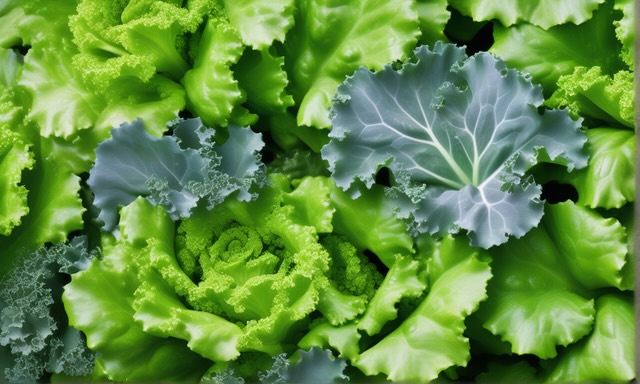Internet Asks: "Baby Kale Nutrition"
Baby kale, the tender, young leaves harvested from the kale plant before it matures, is making waves in the health community. While kale itself has been celebrated as a superfood, its younger counterpart offers a milder taste and softer texture, making it a versatile and palatable addition to a wide range of dishes. This article explores the nutritional profile of baby kale and why it deserves a spot in your diet.
sponsored links

Nutritional Breakdown of Baby Kale
Baby kale is a nutrient-dense leafy green, packed with essential vitamins, minerals, and antioxidants, yet low in calories, making it an excellent choice for those looking to enrich their diet without adding extra calories. Here's a snapshot of what these vibrant greens have to offer per 100 grams (about 3.5 ounces):
- - Calories: Low in calories, making it an excellent choice for weight management.
- - Vitamin K: Essential for blood clotting and bone health.
- - Vitamin A: Important for vision, immune function, and skin health.
- - Vitamin C: A powerful antioxidant that supports immune health and skin integrity.
- - Iron: Vital for oxygen transport in the blood.
- - Minerals: Contains essential minerals like calcium, potassium, and magnesium, contributing to bone health, blood pressure regulation, and muscle function.
- - Antioxidants: High in antioxidants such as beta-carotene, quercetin, and kaempferol, which combat oxidative stress and may reduce the risk of chronic diseases.
- - Fiber: A good source of dietary fiber, aiding in digestion and promoting a feeling of fullness.
Health Benefits of Baby Kale
Incorporating baby kale into your diet can offer numerous health benefits:
- - Boosted Immunity: The vitamin C in baby kale acts as an immune booster, enhancing the body's ability to fight off infections.
- - Improved Eye Health: Rich in vitamin A and beta-carotene, baby kale supports good vision and eye health.
- - Enhanced Bone Strength: The abundance of vitamin K in baby kale is crucial for bone health and may help prevent osteoporosis.
- - Heart Health: The fiber, potassium, and antioxidants in baby kale contribute to cardiovascular health by lowering blood pressure and reducing inflammation.
- - Detoxification: The glucosinolates in baby kale support the body's detoxification processes, helping to neutralize and eliminate toxins.
sponsored links
Comparing Baby Kale to Mature Kale
While both baby and mature kale are nutritionally beneficial, there are subtle differences. Baby kale's leaves are softer and less bitter, making them more palatable when eaten raw in salads or smoothies. On the other hand, mature kale's tougher texture is ideal for cooking, as it holds up well in soups and stews. In terms of nutrition, both varieties are similar, though baby kale may be slightly less concentrated in nutrients due to its younger age.
Incorporating Baby Kale into Your Diet
Baby kale's tender texture and mild taste make it a versatile ingredient in the kitchen. Here are some ideas to incorporate baby kale into your meals:
- - Salads: Use baby kale as a nutritious base for salads, mixing it with other greens, fruits, nuts, and a light dressing.
- - Smoothies: Blend baby kale with fruits like bananas and berries for a nutrient-packed smoothie.
- - Sautéed Dishes: Sauté baby kale with garlic and olive oil for a simple yet delicious side dish.
- - Snacks: Add baby kale to omelets, frittatas, or use it as a fresh topping for pizzas and sandwiches.
- - Soups and Stews: Add baby kale to soups and stews in the last few minutes of cooking for added color and nutrition.
Conclusion
Baby kale stands out not only for its nutritional benefits but also for its culinary versatility and mild taste. Whether you're looking to boost your vitamin intake, improve your diet's antioxidant profile, or simply enjoy a tender, flavorful green, baby kale is an excellent choice. By incorporating this young leafy green into your meals, you can enjoy a wide array of health benefits in a delicious, accessible way.
Disclaimer: This article is for informational purposes only. Always consult with a healthcare provider or a registered dietitian for personalized nutritional advice, especially if you have specific health conditions or dietary needs.
sponsored links
References
1. Today's Dietitian. Hail to Kale. https://www.todaysdietitian.com/newarchives/AM22p42.shtml
2. A-Z Animals. Baby Kale vs. Kale: 6 Key Differences. https://a-z-animals.com/blog/baby-kale-vs-kale-key-differences/
3. USDA FoodData Central. https://fdc.nal.usda.gov/
4. Olivia's Organics. Baby Kale. https://oliviasorganics.org/products/baby-kale/#table
5. WebMD. Health Benefits of Kale. https://www.webmd.com/diet/health-benefits-kale
6. WebMD. Top Foods High in Vitamin C. https://www.webmd.com/diet/foods-high-in-vitamin-c
7. Monash University. Recipes. https://www.monashfodmap.com/recipe/?page=5&search=&category=5
8. Alfawaz HA, Wani K, Alrakayan H, Alnaami AM, Al-Daghri NM. Awareness, Knowledge and Attitude towards 'Superfood' Kale and Its Health Benefits among Arab Adults. Nutrients. 2022 Jan 7;14(2):245. doi: 10.3390/nu14020245. PMID: 35057426; PMCID: PMC8782012.
People are also reading...
Calories in Small Avocado
Calories Small Avocado
1 Small Avocado Calories
Calories in KFC Coleslaw
Does Gatorade Have Vitamin C?
Herbs High in Vitamin C
Kale FODMAP
Sausage and Kale Pasta
Kale Lettuce
KFC Coleslaw Nutrition
Kale Slaw
KFC Coleslaw Calories
Ready to level-up?
Create meal plans 10x faster, follow up with your clients through our mobile app, and never struggle with meal planning or recipe management again.